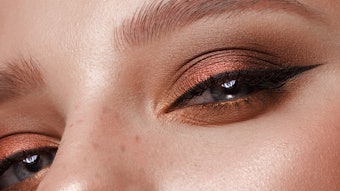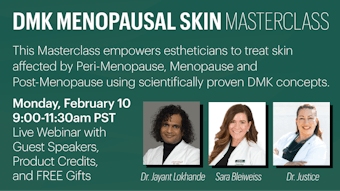“I wear not my dagger in my mouth,” wrote William Shakespeare in the fourth act of his play, Cymbeline.
He may have been referring to sharp words; however, the mouth never should be portrayed as a negative aspect of the face. In today’s spas and medical spas, the emphasis usually is on the skin, eyes, crow’s-feet and worry lines. With all the focus directed to these high-impact areas, the mouth can become something of an afterthought. Nevertheless, no one ever has said that the mouth was the window to the soul. There are specialized eye masks, serums for tough forehead wrinkles and décolleté creams, but the mouth often is not given the care that the rest of the face receives. When this happens, it whispers a vital secret your clients don’t want the world to know—their age.
The aging mouth
The mouth ages in three basic ways, just like the face: by thinning, sagging and wrinkling. Drooping skin around the mouth can create a fatigued expression or make a person appear to be depressed. “The problem comes when these expressions are not the reality of how one feels, but are symbols that inaccurately convey the mood, personality or physical condition of an individual,” says Byron Poindexter, MD, partner and surgeon at The Austin-Weston Center for Cosmetic Surgery in Reston, Virginia. He adds, “For instance, you are immediately drawn to believe that a tired or unhappy expression means that the person is tired or unhappy. Ideally, the face in repose should be neutral from emotion, and reflect a youthful and rested condition.”
Pre- and post-operative skin care
The mouth always should be addressed with every facial a client or patient receives in a spa or medical facility. While physicians perform specific surgeries and invasive cosmetic procedures on the mouth, estheticians working in a medical setting often administer noninvasive esthetic treatments, such as microdermabrasion, chemical peels and clinical facials, with prescription-grade products. Some of the key ingredients found in medical skin care products include hydroquinone, topical retinoids, salicylic acid, glycolic acid, alpha hydroxy acids (AHAs) and beta hydroxy acids (BHAs), trichloroacetic acid and L-ascorbic acid. Many times at medical spas, because of the clinical setting with medically supervised spa treatments, an esthetician is able to achieve visible results that are not attainable in traditional spas. Every patient should receive a thorough, personalized skin care evaluation and a treatment created just for them, as well as a customized regimen for at-home care.
It is crucial for estheticians working in a medical environment to get patients’ skin in the best possible condition before their cosmetic surgeries. Healthy skin heals faster and yields better results. Four to six weeks before surgery, an esthetician should analyze the patient’s skin, develop a personalized skin care regimen and perform a clinical facial, such as a resurfacing treatment, for optimal cleansing. According to Robert K. Sigal, MD, Austin-Weston Center partner and surgeon, “Ingredients such as retinol decrease the thickness of the outer layer of the skin and make it easier for it to be penetrated by lasers. It also increases blood flow, which helps the skin heal faster.”
The esthetician working in conjunction with a medical setting also provides a valuable service to patients through post-operative care by helping to treat the inflammation and redness that result from surgeries, laser services and chemical peels. The area around the mouth tends to be especially prone to redness after treatments. Teach your patients how to care for their skin while it is healing, including utilizing proper massage techniques to help circulate blood and shorten healing time. Patients also often must learn how to apply camouflage makeup to make the recovery process less stressful, because bruising is common. Instruct them on how to cover the bruises with a mineral makeup that is nonirritating and promotes healing. As the bruises change color over time, the makeup routine needs to be adjusted to accommodate the transformation, keeping the camouflage light in order to divert attention.
As a part of patients’ complete transformations, the esthetician’s work is an important element in providing complete skin care services and ensuring that their experiences are a total success. Pre- and post-operative care, ongoing skin care maintenance and the development of personal relationships with patients make it a rewarding situation for all involved.
The mouth speaks volumes
New cosmetic surgery techniques recently have been developed to address the fact that the mouth frequently remains visibly old in appearance, even after a face lift has been performed, making it obvious that an operation has occurred. By combining different mouth protocols with a face lift, it is possible to create a more natural and complete outcome, resulting in the patient looking younger than with the lift alone. “In almost all cases, we perform several mouth procedures in combination at the same time as the facial rejuvenation,” says Austin-Weston Center co-founder George Weston, MD. “It is common for patients to look 10–15 years younger, in contrast to the usual 7–10 years from face lift and eyelid surgery alone.”
Lip lift. One specific surgical procedure performed is a lip lift. As the mouth ages, the upper lip sags, the corners droop and the vermilion—the red part of the lips—thins. With parted lips, a young mouth shows the upper teeth; an old mouth reveals the lower teeth. A lip-lift shortens a long upper lip, averting it slightly and exposing the upper teeth.
Direct incision. Another procedure is a direct incision. Extra tissue often forms with age and sags at the corners of the mouth. Sometimes the best option is to cut it off directly and, with precision, close the incision.
Lip augmentation. Lip augmentation involves restoring the lost volume of the lips to re-create a youthful pout. This is achieved through either surgical rearrangement of tissue in the lips or with fat injections.
Mouth resurfacing. Similar to the rest of the face, mouth resurfacing involves dermabrasion, lasers or chemical peels, in combination with fat grafting, to achieve a natural result.
Corner lift. The corner lift takes about a half-hour and is performed along with a face lift. The scars are not easily visible because they are hidden in the vermilion of the lips. A mouth with turned-down edges connotes both aging and unhappiness. This perception can be a matter of only a few millimeters of drooping at the corners. This simple technique has altered patients’ lives by making them no longer look angry. They feel happier because they look happier.
The power of expressions
This demonstrates the power of expressions—they become problematic when personalities start to reflect them. The collective feedback you receive from your mirror, as well as from other people, serves as instructions. So, gradually and without realizing it, your personality can shift to match your expression. “One of the most important functions of cosmetic surgery is to create a harmony or a ‘truth’ between what is seen on the outside and what is felt on the inside,” says Sigal. “Cosmetic surgery is about altering the symbols that tell lies about us.”










